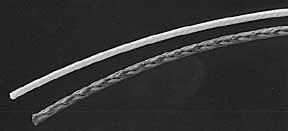|
|

Matching String Gauge And Tension
By Steve Crandall
Vice President, Sales & Marketing
Ashaway Racket Strings
 Much of the power in a badminton racket comes from the "trampoline effect"-the rapid stretch and rebound of the string bed as it contacts the shuttlecock. The more resilient the string bed, the more power it generates. Thin string is naturally more resilient than thick string. And string strung at low tension can stretch more than string strung at high tension. So if you want to increase power in your game (and who doesnít?), there are two ways to approach it. Much of the power in a badminton racket comes from the "trampoline effect"-the rapid stretch and rebound of the string bed as it contacts the shuttlecock. The more resilient the string bed, the more power it generates. Thin string is naturally more resilient than thick string. And string strung at low tension can stretch more than string strung at high tension. So if you want to increase power in your game (and who doesnít?), there are two ways to approach it.
The other side of the coin is control. The more the string bed stretches on impact, the harder it is to control direction and spin on the shuttlecock. (Picture trying to play ping pong with a soup bowl instead of a flat paddle.) This is especially important for off-center hits, where the strings stretch more on one side of the shuttlecock than the other, making an off-center "trampoline."
Control is also affected by a second phenomenon, that I call "dwell time." The more the string stretches, the longer the dwell time, during which the shuttlecock remains in contact with the racket face. With a stiff string bed, the shuttlecock bounces off the racket face at a single instant. The player can both see and feel the instant of contact, and can adjust the racket angle accordingly. But with a stretchier string bed, the shuttlecock is "carried" by the racket as it swings through many degrees of arc. Itís difficult for the player to know exactly when the two are finally going to part company, so itís harder to make the proper adjustments.
Using thicker string, or stringing at higher tension, will produce a stiffer string bed and enhance control over the shuttlecock-just the opposite, naturally, of the rules for stringing for power. But hereís another factor to consider: at the same amount of pounds-tension, a thinner string is stretched more than a thick one, so the thin string behaves as if itís tighter. If youíve been playing with 20 gauge string, strung at 22 lb. of tension, and you switch to thinner, 21-micro gauge to obtain more power, youíll probably have to reduce tension to 17 or 18 lb. At 22 lb., the thinner string would feel too tight, and youíd actually sacrifice power, as compared to the thicker string. (For jargon junkies, weíll call this phenomenon "relative tension.").
By changing the tension, you can adjust the amount of power or control that you get from any string, thick or thin. But that does not mean that thick and thin strings can be made to behave identically. Thin strings penetrate the cork tip of the shuttlecock a bit deeper on impact, and this tends to enhance control. And thinner strings generate less resistance through the air, so the racket can be swung a bit faster, for more power. Both of these factors are so small, however, that few players can detect them at all.
On the other hand, thicker strings are more durable, and they hold tension longer, so they can save you money. And if youíre not the kind of player who re-strings frequently, you may get better performance over the long run from thicker strings.
For a summary of these considerations, see the accompanying table.
| Stringing Choices |
Power |
Control |
Durability |
| Thin gauge/Loose Tension |
High |
Low |
Medium |
| Thin gauge/Tight Tension |
Medium |
Medium |
Low |
| Thick gauge/Loose Tension |
Medium |
Medium |
High |
| Thick gauge/Tight Tension |
Low |
High |
Medium |
|